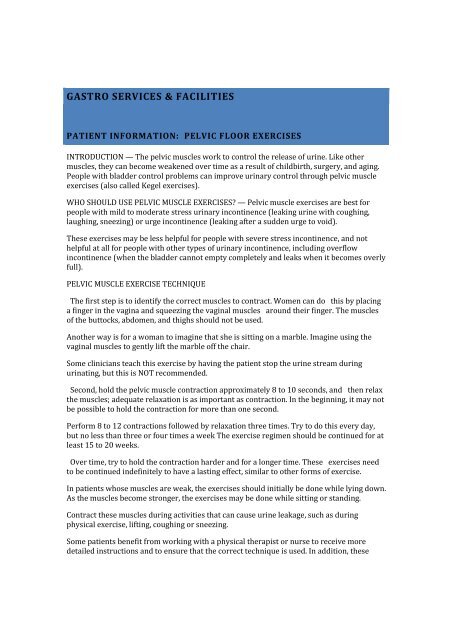Pelvic floor exercise - Gastro Services and Facilities
Pelvic floor exercise - Gastro Services and Facilities
Pelvic floor exercise - Gastro Services and Facilities
You also want an ePaper? Increase the reach of your titles
YUMPU automatically turns print PDFs into web optimized ePapers that Google loves.
GASTRO SERVICES & FACILITIES<br />
PATIENT INFORMATION: PELVIC FLOOR EXERCISES<br />
INTRODUCTION — The pelvic muscles work to control the release of urine. Like other<br />
muscles, they can become weakened over time as a result of childbirth, surgery, <strong>and</strong> aging.<br />
People with bladder control problems can improve urinary control through pelvic muscle<br />
<strong>exercise</strong>s (also called Kegel <strong>exercise</strong>s).<br />
WHO SHOULD USE PELVIC MUSCLE EXERCISES? — <strong>Pelvic</strong> muscle <strong>exercise</strong>s are best for<br />
people with mild to moderate stress urinary incontinence (leaking urine with coughing,<br />
laughing, sneezing) or urge incontinence (leaking after a sudden urge to void).<br />
These <strong>exercise</strong>s may be less helpful for people with severe stress incontinence, <strong>and</strong> not<br />
helpful at all for people with other types of urinary incontinence, including overflow<br />
incontinence (when the bladder cannot empty completely <strong>and</strong> leaks when it becomes overly<br />
full).<br />
PELVIC MUSCLE EXERCISE TECHNIQUE<br />
The first step is to identify the correct muscles to contract. Women can do this by placing<br />
a finger in the vagina <strong>and</strong> squeezing the vaginal muscles around their finger. The muscles<br />
of the buttocks, abdomen, <strong>and</strong> thighs should not be used.<br />
Another way is for a woman to imagine that she is sitting on a marble. Imagine using the<br />
vaginal muscles to gently lift the marble off the chair.<br />
Some clinicians teach this <strong>exercise</strong> by having the patient stop the urine stream during<br />
urinating, but this is NOT recommended.<br />
Second, hold the pelvic muscle contraction approximately 8 to 10 seconds, <strong>and</strong> then relax<br />
the muscles; adequate relaxation is as important as contraction. In the beginning, it may not<br />
be possible to hold the contraction for more than one second.<br />
Perform 8 to 12 contractions followed by relaxation three times. Try to do this every day,<br />
but no less than three or four times a week The <strong>exercise</strong> regimen should be continued for at<br />
least 15 to 20 weeks.<br />
Over time, try to hold the contraction harder <strong>and</strong> for a longer time. These <strong>exercise</strong>s need<br />
to be continued indefinitely to have a lasting effect, similar to other forms of <strong>exercise</strong>.<br />
In patients whose muscles are weak, the <strong>exercise</strong>s should initially be done while lying down.<br />
As the muscles become stronger, the <strong>exercise</strong>s may be done while sitting or st<strong>and</strong>ing.<br />
Contract these muscles during activities that can cause urine leakage, such as during<br />
physical <strong>exercise</strong>, lifting, coughing or sneezing.<br />
Some patients benefit from working with a physical therapist or nurse to receive more<br />
detailed instructions <strong>and</strong> to ensure that the correct technique is used. In addition, these
providers may use biofeedback to improve <strong>exercise</strong> technique <strong>and</strong> strength; this provides a<br />
visual demonstration of how well the muscles contract <strong>and</strong> relax. A computer monitor<br />
shows as the muscles contract <strong>and</strong> relax, <strong>and</strong> also indicates if the wrong muscles are used.<br />
RESULTS — Studies have shown that, if done correctly, pelvic muscle <strong>exercise</strong>s can be<br />
effective in people with stress incontinence because the <strong>exercise</strong>s improve muscle strength.<br />
This strength can also be used to stop a sudden urge to void that may result in urine<br />
leakage. If there is a sudden sense of urgency that may cause urine leakage, patients are<br />
advised to sit or st<strong>and</strong> still <strong>and</strong> contract the pelvic muscles. After the urge diminishes, the<br />
patient can then proceed to the toilet.<br />
Most people notice an improvement after three to four months. It is important to continue<br />
the <strong>exercise</strong>s in order to maintain bladder control. Patients with mild fecal leakage (leakage<br />
of stool) may have improvement in the amount <strong>and</strong> frequency of fecal leakage as well.<br />
If these <strong>exercise</strong>s are not helpful, please speak with a healthcare provider. Other muscle<br />
training <strong>and</strong> rehabilitation techniques, medical treatments, <strong>and</strong> surgical treatments are<br />
available <strong>and</strong> may be recommended.<br />
GASTRO SERVICES & FACILITIES<br />
DR JOHN GIBBONS, DR KATE CAYZER, DR GEORGIA HUME, DR JILLIAN ROSENSTENGEL<br />
CONSULTANT GASTROENTEROLOGISTS<br />
120 BIRKDALE RD<br />
BIRKDALE QLD 4159<br />
PH 07 3820 4555 FAX 3207 1066



